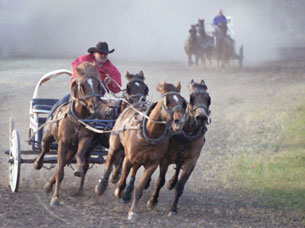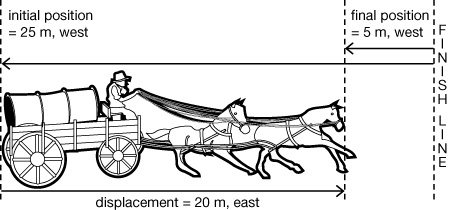Module 1—Motion
 Explore
Explore

© southpaw3/BigStockPhoto
In a chuckwagon race, or in any race for that matter, the participants’ location on the track is measured with respect to the starting line, which is known as the reference point or origin. The length of the path travelled by each chuckwagon is called the distance. To fully describe exactly where a chuckwagon is on the course, you need to give more than just a value for its distance.
distance: the length of the path taken to move from one place to another
position: the straight-line distance and direction of an object from the origin
displacement: a change in position including both magnitude and direction
vector quantity: a measurement that has a magnitude and a direction
scalar quantity: a measurement that has only magnitude
One approach is to give the direction from a reference point or origin along with the distance. If you said that a chuckwagon is 25 m west of the finish line, then you would be describing its position, abbreviated as ![]() .
.
If a chuckwagon was able to move from 25 m west of the finish line to 5 m west of the finish, then its position has changed—the chuckwagon is 20 m farther east than it was before. This change in position, of 20 m east, is called displacement.
Both position and displacement have a size or a magnitude—measured in metres—and a direction. This is why position and displacement are each an example of a vector quantity.
Distance is not a vector because it has no direction associated with it, so it is called a scalar quantity.

 Read
Read
To learn more about displacement and position and how to work with these vector quantities, read “Physics Terms” and “Sign Conventions” on pages 6 to 10 of your textbook.
 Self-Check
Self-Check
SC 1. The start of a chuckwagon race was captured on digital video by a friend of one of the competitors. The video revealed that just 8.5 seconds (s) into the race, the competitor had already moved to a location 12 m [W] of the start and that by 10.0 s this same competitor had moved to a spot 20 m [W] of the start. This information was analyzed by the competitor after the race to improve performance.
-
Determine which of the four measurements in the description of the video are vector quantities and which are scalar quantities. Support your answers.
-
Determine the displacement of the chuckwagon from 8.5 s to 10.0 s.
-
Use a sign convention to complete a calculation that verifies your answer to to SC 1.b.
SC 2. A digital video recording of a chuckwagon race was used to determine that a chuckwagon was moving at 9.0 m/s at one point in the race. Later footage helped establish that the winner crossed the finish line moving at 12.5 m/s [W].
-
Determine which of the two measurements in the description of the video is a vector quantity and which is a scalar quantity. Support your answers.
-
Use the proper physics variables to describe each of these measurements.
 Self-Check Answers
Self-Check Answers
SC 1.
- The measurements of time, 8.5 s and 10.0 s, are examples of scalar quantities because these measurements have only magnitude. The measurements of position, 12 m [W] and 20 m [W], are examples of vector quantities because these measurements have both magnitude and direction.
- The displacement of the chuckwagon is from 8.5 s to 10.0 s is 8 m [W]. This value represents the change in the position during this time.
Given
Note that east is considered to be the positive direction, while west is negative.

Required
![]()
Analysis and Solution

The answer is negative, so the direction is west.
Paraphrase
The displacement of the chuckwagon is 8 m west of the initial position.
SC 2.
- The measurement of speed, 9.0 m/s, is a scalar quantity because this measurement has only magnitude. The measurement of velocity, 12.5 m/s [W], is a vector quantity because this measurement has both magnitude and direction.
- The speed of the chuckwagon can be described as v = 9.0 m/s. The velocity of the chuckwagon can be described as
 , or
, or 